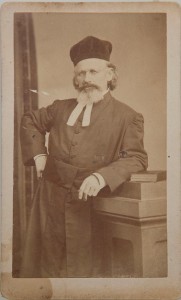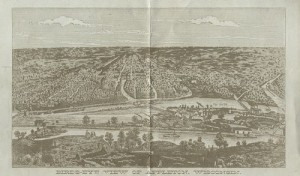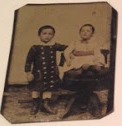Since today is Father’s Day, I thought I would do a post about Houdini’s Father, Mayer Samuel Weiss, born August 27, 1829, died October 5, 1892:
- When did Houdini’s Father depart for America and arrive in Appleton?
According to Hardeen notes for an unpublished Houdini biography:
Chapter one
Father insulted by prince Eric — challenged to dule- which was fought following morning and _ather killing his opponent Then fled to London and stayed there for a time after which he took sailing vessel to New York.
After reaching New York kept going to Appleton Wis. where he had friends by the name of Hammel, one being Mayor of Appleton at thattime.. About 1874.
A short time passed and as there were no syniogues in the town, the Mayor wanted to send to Milwaukee for one, but up spoke Mr. S.M. Weiiss and said “why I am a Rabbi” and was given the job.
He at once sent for Mrs. W. and soon after her arrival Houdini was born April 6th, 1874. And he was named Ehrich Prach after Prince Ehrich.
[The Houdini Birth Research Committee’s Report]
Harry Houdini also gave dissimilar accounts of his father’s reasons for coming to America, and way of reaching America.
In one of them, Mayer Samuel had been an “honor student” in England who won a prize of a trip through America, given by Lord Rothschild. On the train going to the Pacific coast, he met a congenial man who appealed to him to stop off at Appleton, in northern Wisconsin, as his father did, establishing himself as a rabbi there and making it his permanent home, and the birthplace of his son.
[Silverman Notes to Houdini]
According to Weltman (Houdini: Escape Into Legend The Early Years: 1862-1900):
Soon after the American Civil War ended, between 1865 and 1866, the two sisters [of Cecilia], Rose and Sally, moved to the United States with their families and their mother, taking up residence in New York. Rabbi Weisz, not having enough money to make the journey, had to stay behind. He was to toil and save for several years before he would see his in-laws again [no date given].
Life in Budapest was hard. One legend has it that Rabbi Weisz got into a duel with a Hungarian nobleman over an aspersion the nobleman cast on the Jews. It seems unlikely, however, that Weisz would have had the weapons or would have come into sufficient contact with nobility for this to have occurred, although as a people, Jews were forced to move from town to town and in fact, the birth records of his children list several different addresses. In any event, with four children to feed, Rabbi Weisz needed more for survival. It does seem likely, as has been reported, that answering an ad in a German periodical, Weisz was offered the position of Rabbi for a new congregation being formed in the small American town of Appleton, Wisconsin. The purported annual salary of $750 being offered seemed like a fortune to the poor struggling Rabbi and his family.
According to Christopher (The Untold Story):
Shortly after this Samuel left Budapest [no date given]. It is said that a nobleman slandered him and his religion. A duel was fought and his opponent was killed. To escape arrest and the vengeance of the dead man’s family, Samuel fled to London and there embarked for the United States to seek refuge with Hungarian friends who had settled in Appleton, Wisconsin.
Cecilia, her mother, and the four children may have been there before Samuel arrived; if not, they joined him soon after. There was no synagogue in Appleton. When one was formed in the spring of 1874, Samuel became its rabbi at a salary of $750 a year.
According to Hilgert (Houdini comes to America):
Houdini, then Ehrich Weiss arrived in New York City with his mother and four brothers on Wednesday July 3, 1878 aboard the Frisia, a steamship of the Hamburg Line.
The Weiss family may have been met at Castle Garden by Cecelia Weiss’s sister, Rosalie Schonberger. She lived in New York and may have helped the family to find a temporary place to stay before they left for Appleton. Mrs. Schonberger came to New York in the 1860s. Her death certificate dated February 26, 1915 shows she had resided in the U.S. for 47 years, implying that she arrived in 1867 or 1868. The 1900 census shows the year of emigration to the U.S. as 1865.
On July 3, 1878, or some time shortly thereafter, the Weiss family was reunited with Rabbi Weiss. Apparently within a few weeks the family set forth on their journey, probably by railroad to Chicago, Milwaukee and finally to their new home in Appleton, Wisconsin, where Rabbi Weiss was to lead a small congregation. There Harry found his American home from which he was to go forth to become famous throughout the world as “the elusive American”.
Well, so far the above sources do not tell us when he actually departed for America or when he arrived in Appleton, Wisconsin. Not to worry, Silverman (Houdini!!! The Career of Ehrich Weiss) finally provides an answer:
When he departed Europe, Weiss (originally Weisz) was no longer young. A rabbi with several years’ education at German universities and some training in law, he emigrated from Budapest in 1876, when he was forty-seven. He temporarily left behind his family: his second wife, Cecilia Steiner [who was pregnant with Hardeen], a small, stocky woman twelve years younger than he; their four sons, ranging in age from infancy [Hardeen not born yet] to six years; and a fourteen-year-old son from his first marriage. After two years in America he located a rabbinical post in the Midwest, where Cecilia and the children joined him. They embarked from Hamburg, among 322 steerage passengers of the single-screw steamer Frisia, a fifteen day voyage reached New York City on July 3, 1878, in ninety-five degree heat. By September the family had reunited and settled in Appleton, Wisconsin.
Note: The September date is apparent from the announcement of Mayer Samuel’s arrival in the Appleton Crescent, 28 Sep 1878. And the 1876 date is based on a remark Houdini made that upon Hardeen’s birth [March 4, 1876], Cecilia wrote to Mayer from Hungary, “Da haben wire in Dezso.”; Since Hardeen was two when the family arrived in America, the separation must have lasted about that length of time.
If you are looking for additional information, I highly recommend you read the following posts by our friend David Saltman, who has done some extensive research on the subject:
H A P P Y F A T H E R ‘ S D A Y !





Very interesting gathering of the facts. So the question arises: what was
Samuel doing in the two years between 1876 and 1878? Hanging around New York with his in-laws (whom we believe did not think much of him)? They were wealthy then, one in the yeast business and another making cigars (if memory serves). If Samuel met Hammel on the train, where was he headed originally, and why? Hammel was building the Democratic party in Wisconsin back then and he apparently encouraged many people to come to Appleton because it meant more votes for him. The story is still murky, but seems to be clearing slowly. And – thanks for the kind referrals!
I agree the story is still murky. But, that’s what makes it fun. As always one question leads to more questions. Hopefully with your help, we can chip away at the puzzle.
Great post Joe! I was about to recommend Saltman’s writings on this subject but you’re way ahead. I like to remind fellow Houdini scholars that many years ago Silverman mentioned in an interview that more Houdini information would eventually surface. As thorough as he was in Houdini!!!, he was humble enough to say that his book was not the last word.
Thanks Leo! Like you, and others, I look forward to more Houdini information surfacing.